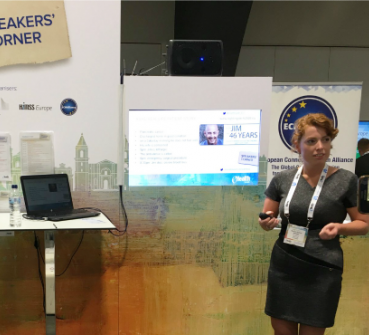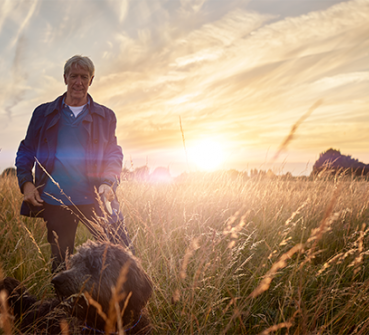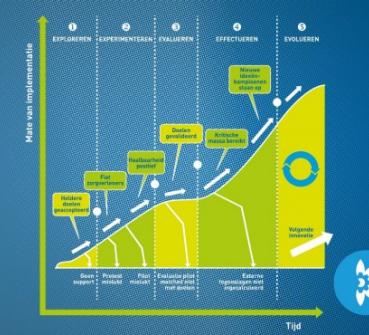Day 1 in Silicon Valley: Proud of the Netherlands
This morning, my traveling companion and I got up early to attend our first appointment at the Consulate. Thijs Boekhoff of the Healthcare Innovation Transfer program arranged sessions with home care organizations and with people with expertise on the market in the United States, as well as on insurance coverage and on privacy and security legislation. In the afternoon, we visited Kaiser Permanente and the University of California's Center for Aging Services Technologies.
Home care: just go to a nursing home
First, we were able to share our story with people from the home care organizations. They were very interested in the solutions we have to offer and invited us to start trial projects with them. They were particularly impressed by the simple user interface in our cContact App and our cVitals App, which they had not seen previously, in combination with the integrated, holistic approach such as HomeBingo.
As we discussed how to set something like this up, it became clear to us that in Silicon Valley home care is a concept reserved for the fortunate few. It is nothing like how we have organized this in the Netherlands. "That's when you realize that, compared to the American system, our system of solidarity really is unique". Home care in California is very expensive, and for most people who really require home care, the only choice is to move into a nursing home. Such nursing homes are covered for people on lower incomes, while other options, such as regular home care, either are not covered by insurance or the insurance is too expensive for people who need it. One of the people we met told us his insurance costs around $1,200 a month, with a $14,000 deductible before it pays out. Of course the incomes are different here, but still... That's when you realize that, compared to the American system, our system of solidarity really is unique.
Security and Privacy
After speaking to people from the home care organizations, we met with people who know all about business models and privacy and security requirements. It soon became clear that there is a huge difference between Europe and the United States in this area. Privacy legislation in the US is more or less based on the “once given, always given” principle. In other words, if you use a technological service in which you share your data, those data become the property of the company providing the service. Conversely, in Europe you generally remain the owner of your own data even if you do share them online.
There are also a number of requirements with regard to the security of data and the way in which they are processed. These requirements are strictly prescribed by various regulatory bodies. However, because our privacy legislation is so different, most European systems meet the US requirements, whereas the opposite is not the case. So this is an advantage if you want to become active in the United States.
A 37,000-square feet innovation lab
I was really impressed when we left the Consulate and made our way to Kaiser Permanente, a Health Maintenance Organization (HMO) with a revenue of $61 billion, 200,000 employees, 39 hospitals, 600 clinics, 44,000 nurses, 70,000 doctors and almost 10 million patients. What makes Kaiser Permanente unique is that it integrates all elements of healthcare into a single organization: from insurance, pharmacy and specialist medical care to geriatric care.
We were met by the head of the innovation team, who told us how they organize innovation in this gigantic organization. And, I must say, that's something we could learn from in the Netherlands. Innovation is one of the main components of the organization and is organized around three teams: An innovation SWAT team that deals with selection, prototyping and implementation of healthcare innovations. An Advanced Technology team that tries to forecast which innovations Kaiser Permanente can expect in the next two to three years, and a third group consisting of architects who focus mainly on the physical buildings. These teams have access to a permanent innovation process supported by a 'lab' with an area of over 37,000 square feet, featuring a replica hospital, clinic and home in which innovations are tested, developed and tried out with doctors, nurses and patients. The objective is to create innovations (defined as "ideas that add value immediately") that make the system better and more patient-friendly at the same time. It was pretty nerve-wracking to start my modest presentation after such an impressive story about innovation…
Integration is the key
After presenting our story about innovation and the Dutch approach, it soon became clear in which areas the Netherlands truly stands out. Aside from the level of the costs for care and the accompanying coverage, which can be broken down into all kinds of levels depending on your income, here too our orderly approach means a lot. Our system of solidarity features options that are the same for all people, rich or poor. And, although there are certainly factors in our system that get in the way of cooperation between primary and secondary care, our integration of specialist medical care, family medicine and social support means that we really take a comprehensive approach to healthcare instead of isolated silos for each clinical entity or component.
The presented method of Blended HomeCare and Digital Clinic, which we use at FocusCura, is expected to be met by enthusiasm in the US. There were also questions, of course, and we will continue our discussions. But, overall, it was a great outcome, which made me rather proud of the way we do things in the Netherlands.
Video visits, e-mail doctor and chronic care
We concluded the day with an appointment with people from the University of California's Center for Aging Services Technologies. "The time seems riper than ever for scaling up video visits and innovative support of the chronically ill" They too told us about the expectations that exist with regard to healthcare innovation and eHealth, and that there are many pilot projects but still few concepts that have really been scaled up to a large scale. People are looking for implementation methods that work. Therefore, the time seems riper than ever for scaling up video visits (video consultations) and innovative support of the chronically ill (disease management).
In those areas it is interesting to take a closer look and, in particular, to consider the question "who is the customer?" In addition to home care and primary care, there are specialized clinics for chronic care and specialist medical care. And, of course, there are the consumers or patients themselves. Over the next few days, it will be interesting to see which of all these groups has the greatest interest in genuinely improving care. And, in particular, an interest in doing this based on intrinsic motivation rather than financial reasons alone.
Proud…
This intensive day filled with enthusiasm has left me somewhat disoriented. The impression that everyone here embraces technology as a way of improving healthcare appears to be correct. And the great thing is that we have received very positive reactions to the possibilities we can offer in this respect. Indeed, I think we are taking the lead in the Netherlands in various fields. The idea that just about any technological innovation imaginable has been available to everyone in Silicon Valley for a long time is incorrect. The great differences between the insured and the uninsured, between the rich and the poor, and where you turn up with your request for care mean that I can drift off to sleep with a sense of pride. I'm proud of our small country of the Netherlands. Because, despite all the challenges we face in our healthcare system, our healthcare is very accessible to everyone who needs it. And no innovation can match that…
---
Tomorrow's schedule includes visits to two e-health companies. One of these companies is involved in monitoring the chronically ill, and the other focuses entirely on the large market of video consultations in the United States. I wonder what opportunities these visits will bring!
This blog was previously published on Skipr.nl.


